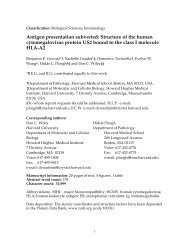X-ray structure of a protein-conducting channel - The Laboratory of ...
X-ray structure of a protein-conducting channel - The Laboratory of ...
X-ray structure of a protein-conducting channel - The Laboratory of ...
Create successful ePaper yourself
Turn your PDF publications into a flip-book with our unique Google optimized e-Paper software.
articlesmodels, but the <strong>structure</strong> now provides the basis for experimentaltesting.AMethodsProtein preparationWe cloned SecY complexes from ten different species into the pBAD22 vector (seeSupplementary Information) under control <strong>of</strong> the arabinose promoter. <strong>The</strong> plasmidscontained the genes for the g-, a- andb-subunits in this order, each with a separatetranslation-initiation site. <strong>The</strong> genes were amplified by polymerase chain reaction (PCR)from genomic DNA, and digested with NcoI/SalI, SalI/XbaI andXbaI/KpnI, respectively.Four-component ligation with NcoI/KpnI-digested pBAD22 resulted in the intergenicsequence AGGAGGAGCATC between the 5 0 restriction site and the initiation codon <strong>of</strong> thea- andb-subunits. <strong>The</strong> g-subunit contained at its N terminus a hexa-histidine tagfollowed by a thrombin cleavage site, resulting after cleavage in the N-terminal sequenceGly-Ser instead <strong>of</strong> Met. <strong>The</strong> following procedure was used for the SecY complex fromM. jannaschii, which gave the highest expression levels and was the most stable in anumber <strong>of</strong> detergents. Initially, we crystallized the SecYE dimer, but the crystals neverdiffracted beyond ,6.5 Å. By consulting sequence databases, we discovered archaealpolypeptides with sequence similarity to the b-subunits in eukaryotes. We co-expressedthe b-subunit from M. jannaschii and found that it associated with SecYE. <strong>The</strong> trimericcomplex turned out to be significantly more stable than the dimer. For its purification,cells <strong>of</strong> E. coli strain C43 (DE3) were induced with 0.2% arabinose for 3 h at 37 8C or12–16 h at room temperature, and lysed on ice in TSG buffer (20 mM Tris, 300 mM NaCl,10% glycerol, pH 7.8) using a micr<strong>of</strong>luidizer. Membranes were collected by centrifugationfor 40 min at 40,000 r.p.m., and solubilized in 1.5% (w/v) 1,2-diheptanoyl-sn-glycero-3-phosphocholine (DHPC; Avanti Polar Lipids) in TSG buffer. After centrifugation for30 min at 40,000 r.p.m., the extract was loaded onto a 15–20 ml Ni column (metalchelatingSepharose, Amersham Pharmacia Biotech). <strong>The</strong> column was washed with 20volumes <strong>of</strong> 0.2% DHPC in TSG buffer in the presence <strong>of</strong> 30 mM imidazole. <strong>The</strong> SecYcomplex was eluted with 300 mM imidazole, exchanged into PBS (pH 7.4) containing 10%glycerol and 0.1% DHPC, and treated with bovine thrombin at 5–10 U mg 21 <strong>protein</strong> for16 h at 30 8C. After adding imidazole to 30 mM, the solution was passed through a small(2 ml) Ni column. Further purification was carried out by gel filtration on Superdex-200 inbuffer A (10 mM HEPES, pH 7.5, 100 mM NaCl, 10% glycerol, 0.1% DHPC), followed byion-exchange chromatography on Mono-S (Pharmacia) using a gradient from 100 mM to400 mM NaCl in buffer A. <strong>The</strong> b-subunit was present at sub-stoichiometric levels relativeto the YE subunits; obtaining crystals depended critically on removing contaminatingSecYE complexes from the trimeric complex, which was achieved by the gel-filtration andion-exchange steps. <strong>The</strong> complex was concentrated to 10–15 mg ml 21 with a CentriprepPlus-20 concentrator (Amicon; molecular mass cut<strong>of</strong>f, 30 kDa) and dialysed overnight at4 8C.Selenomethionine-substituted SecY complex from M. jannaschii was expressed inwild-type C43 (DE3) cells by inhibition <strong>of</strong> the methionine biosynthesis pathway. <strong>The</strong> cellswere grown in M9 minimal medium with 0.2% glucose and 5% (v/v) glycerol as carbonsources, and induced with 1% arabinose. Purification was as described for the native<strong>protein</strong>, with all buffers supplemented with 0.5 mM EDTA and 0.5 mM Tris-(2-carboxyethyl)phosphine to avoid oxidation.CrystallizationCrystallization <strong>of</strong> the M. jannaschii trimeric SecY complex was performed by hangingdropvapour diffusion at 4 8C, mixing 1 ml each <strong>of</strong> <strong>protein</strong> (5–10 mg ml 21 ) and reservoirsolutions. Initial crystallization conditions were found using a broad screen. Afteroptimization, the best crystals were obtained with 50–55% PEG400, 50 mM glycine buffer,pH 9.0–9.5. <strong>The</strong>y appeared overnight and grew to maximum dimensions <strong>of</strong>150 £ 150 £ 400 mm within a week. <strong>The</strong>y belong to space group P2 1 2 1 2 and diffract to3.4 Å. Selenomethionine-substituted crystals <strong>of</strong> the SecY complex were obtained with,45% PEG400.After obtaining an initial model, several double mutants were made in which residuesinvolved in crystal contacts between the C terminus <strong>of</strong> one monomer and the 5/6 loop <strong>of</strong>another were changed. One <strong>of</strong> them (Lys422Arg/Val423Thr), called Y1, crystallized in thinplates at 35% PEG400.Crystals were flash frozen in liquid nitrogen directly from the drop. We discovered thaton gradually increasing the PEG concentration from 35–40% to 52%, the unit cells shranksubstantially (Supplementary Table 1). A similar reduction in cell dimensions wasobserved on soaking certain heavy-atom derivatives such as K 2 PtCl 4 into the crystals. <strong>The</strong>different crystal forms were useful for cross-crystal averaging <strong>of</strong> electron density maps.Data collection, <strong>structure</strong> determination and refinementDiffraction data were collected at 100 K on beamlines at either the National SynchrotronLight Source at Brookhaven National Labs (X25) or the Advanced Photon Source atArgonne National Labs (8BM, 14BM-C, 19ID) (see Table 1). <strong>The</strong> data were indexed andscaled with HKL2000. As the crystals were radiation sensitive, we collected highlyredundant single-wavelength anomalous dispersion (SAD) data sets at the selenium peakwavelength. Thirteen out <strong>of</strong> 15 selenium sites were located using SOLVE. <strong>The</strong> seleniumsites in other crystal forms were found by molecular replacement using AMORE. Aftersolvent flattening with CNS, electron density maps were generated with useful phases to,4Å. An initial model was built with the program O for the a-helical TM segments, usingselenium sites and large amino-acid side chains to determine the registry. <strong>The</strong> model wasimproved by an iterative process, using cross-crystal averaging, solvent flattening andhistogram matching with a modified version <strong>of</strong> DMMULTI, and model building.Molecular replacement with the improved model was used in AMORE to obtain electrondensity maps for the native SecY complex and the Y1 mutant, which were then included inthe averaging. Torsion angle refinement with hydrogen bond restraints and B-factorrefinement <strong>of</strong> the model were performed with the Y1 data set using CNS, resulting in anR free <strong>of</strong> 28.7%. This model was used in the subsequent refinement <strong>of</strong> the wild-type crystalform, giving an R free <strong>of</strong> 33.4%. <strong>The</strong> following residues in the best-refined <strong>structure</strong> <strong>of</strong> thea-subunit were poorly defined, presumably because <strong>of</strong> conformational flexibility: 18–20,48–55, 288–292 and 301–314. Figures shown in the paper were rendered with RIBBONSand POV-Ray (http://www.pov<strong>ray</strong>.org/), except for Fig. 4, which was generated withRaster3D and SPOCK, and Supplementary Fig. S4, which was made using Molscript.Received 14 October; accepted 19 November 2003; doi:10.1038/nature02218.Published online 3 December 2003.1. Matlack, K. E. S., Mothes, W. & Rapoport, T. A. Protein translocation—tunnel vision. Cell 92, 381–390(1998).2. Simon, S. M. & Blobel, G. A <strong>protein</strong>-<strong>conducting</strong> <strong>channel</strong> in the endoplasmic reticulum. Cell 65,371–380 (1991).3. Crowley, K. S., Liao, S. R., Worrell, V. E., Reinhart, G. D. & Johnson, A. E. Secretory <strong>protein</strong>s movethrough the endoplasmic reticulum membrane via an aqueous, gated pore. Cell 78, 461–471 (1994).4. Rapoport, T. A., Jungnickel, B. & Kutay, U. Protein transport across the eukaryotic endoplasmicreticulum and bacterial inner membranes. Annu. Rev. Biochem. 65, 271–303 (1996).5. Mothes, W., Prehn, S. & Rapoport, T. A. Systematic probing <strong>of</strong> the environment <strong>of</strong> a translocatingsecretory <strong>protein</strong> during translocation through the ER membrane. EMBO J. 13, 3937–3982 (1994).6. Brundage, L., Hendrick, J. P., Schiebel, E., Driessen, A. J. M. & Wickner, W. <strong>The</strong> purified E. coli integralmembrane <strong>protein</strong> SecY/E is sufficient for reconstitution <strong>of</strong> SecA-dependent precursor <strong>protein</strong>translocation. Cell 62, 649–657 (1990).7. Gorlich, D. & Rapoport, T. A. Protein translocation into proteoliposomes reconstituted from purifiedcomponents <strong>of</strong> the endoplasmic reticulum membrane. Cell 75, 615–630 (1993).8. Deshaies, R. J., Sanders, S. L., Feldheim, D. A. & Schekman, R. Assembly <strong>of</strong> yeast Sec <strong>protein</strong>s involvedin translocation into the endoplasmic reticulum into a membrane-bound multisubunit complex.Nature 349, 806–808 (1991).9. Panzner, S., Dreier, L., Hartmann, E., Kostka, S. & Rapoport, T. A. Posttranslational <strong>protein</strong> transportin yeast reconstituted with a purified complex <strong>of</strong> Sec <strong>protein</strong>s and Kar2p. Cell 81, 561–570 (1995).10. Matlack, K. E., Misselwitz, B., Plath, K. & Rapoport, T. A. BiP acts as a molecular ratchet duringposttranslational transport <strong>of</strong> prepro-a-factor across the ER membrane. Cell 97, 553–564 (1999).11. Economou, A. & Wickner, W. SecA promotes pre<strong>protein</strong> translocation by undergoing ATP-drivencycles <strong>of</strong> membrane insertion and deinsertion. Cell 78, 835–843 (1994).12. Schiebel, E., Driessen, A. J. M., Hartl, F.-U. & Wickner, W. DmH þ and ATP function at different steps <strong>of</strong>the catalytic cycle <strong>of</strong> pre<strong>protein</strong> translocase. Cell 64, 927–939 (1991).13. Irihimovitch, V. & Eichler, J. Post-translational secretion <strong>of</strong> fusion <strong>protein</strong>s in the halophilic archaeaHal<strong>of</strong>erax volcanii.. J. Biol. Chem. 278, 12881–12887 (2003).14. Hanein, D. et al. Oligomeric rings <strong>of</strong> the Sec61p complex induced by ligands required for <strong>protein</strong>translocation. Cell 87, 721–732 (1996).15. Beckmann, R. et al. Alignment <strong>of</strong> conduits for the nascent polypeptide chain in the ribosome-Sec61complex. Science 19, 2123–2126 (1997).16. Menetret, J. et al. <strong>The</strong> <strong>structure</strong> <strong>of</strong> ribosome-<strong>channel</strong> complexes engaged in <strong>protein</strong> translocation. Mol.Cell 6, 1219–1232 (2000).17. Beckmann, R. et al. Architecture <strong>of</strong> the <strong>protein</strong>-<strong>conducting</strong> <strong>channel</strong> associated with the translating80S ribosome. Cell 107, 361–372 (2001).18. Morgan, D. G., Menetret, J. F., Neuh<strong>of</strong>, A., Rapoport, T. A. & Akey, C. W. Structure <strong>of</strong> the mammalianribosome-<strong>channel</strong> complex at 17Å resolution. J. Mol. Biol. 324, 871–886 (2002).19. Breyton, C., Haase, W., Rapoport, T. A., Kuhlbrandt, W. & Collinson, I. Three-dimensional <strong>structure</strong><strong>of</strong> the bacterial <strong>protein</strong>-translocation complex SecYEG. Nature 418, 662–665 (2002).20. Murata, K. et al. Structural determinants <strong>of</strong> water permeation through aquaporin-1. Nature 407,599–605 (2000).21. Dutzler, R., Campbell, E. B., Cadene, M., Chait, B. T. & MacKinnon, R. X-<strong>ray</strong> <strong>structure</strong> <strong>of</strong> a ClCchloride <strong>channel</strong> at 3.0 A reveals the molecular basis <strong>of</strong> anion selectivity. Nature 415, 287–294 (2002).22. Flower, A. M., Osborne, R. S. & Silhavy, T. J. <strong>The</strong> allele-specific synthetic lethality <strong>of</strong> prlA-prlG doublemutants predicts interactive domains <strong>of</strong> SecY and SecE. EMBO J. 14, 884–893 (1995).23. Murphy, C. K. & Beckwith, J. Residues essential for the function <strong>of</strong> SecE, a membrane component <strong>of</strong>the Escherichia coli secretion apparatus, are located in a conserved cytoplasmic region. Proc. Natl Acad.Sci. USA 91, 2557–2561 (1994).24. Satoh, Y., Mori, H. & Ito, K. Nearest neighbor analysis <strong>of</strong> the SecYEG complex. 2. Identification <strong>of</strong> aSecY-SecE cytosolic interface. Biochemistry 42, 7442–7447 (2003).25. Nishiyama, K., Suzuki, T. & Tokuda, H. Inversion <strong>of</strong> the membrane topology <strong>of</strong> SecG coupled withSecA-dependent pre<strong>protein</strong> translocation. Cell 85, 71–81 (1996).26. Harris, C. R. & Silhavy, T. J. Mapping an interface <strong>of</strong> SecY (PrlA) and SecE (PrlG) by using syntheticphenotypes and in vivo cross-linking. J. Bacteriol. 181, 3438–3444 (1999).27. Hamman, B. D., Hendershot, L. M. & Johnson, A. E. BiP maintains the permeability barrier <strong>of</strong> the ERmembrane by sealing the lumenal end <strong>of</strong> the translocon pore before and early in translocation. Cell 92,747–758 (1998).28. Kurzchalia, T. V. et al. tRNA-mediated labelling <strong>of</strong> <strong>protein</strong>s with biotin. A nonradioactive method forthe detection <strong>of</strong> cell-free translation products. Eur. J. Biochem. 172, 663–668 (1988).29. Tani, K., Tokuda, H. & Mizushima, S. Translocation <strong>of</strong> proOmpA possessing an intramoleculardisulfide bridge into membrane vesicles <strong>of</strong> Escherichia coli. Effect <strong>of</strong> membrane energization. J. Biol.Chem. 265, 17341–17347 (1990).30. Mingarro, I., Nilsson, I., Whitley, P. & von Heijne, G. Different conformations <strong>of</strong> nascent polypeptidesduring translocation across the ER membrane. BMC Cell Biol. 1, 3 (2000).31. Kowarik, M., Kung, S., Martoglio, B. & Helenius, A. Protein folding during cotranslationaltranslocation in the endoplasmic reticulum. Mol. Cell 10, 769–778 (2002).32. Hamman, B. D., Chen, J. C., Johnson, E. E. & Johnson, A. E. <strong>The</strong> aqueous pore through the transloconhas a diameter <strong>of</strong> 40–60Å during cotranslational <strong>protein</strong> translocation at the ER membrane. Cell 89,535–544 (1997).33. Jungnickel, B. & Rapoport, T. A. A posttargeting signal sequence recognition event in the endoplasmicreticulum membrane. Cell 82, 261–270 (1995).NATURE | VOL 427 | 1 JANUARY 2004 | www.nature.com/nature 43© 2003 Nature Publishing Group






